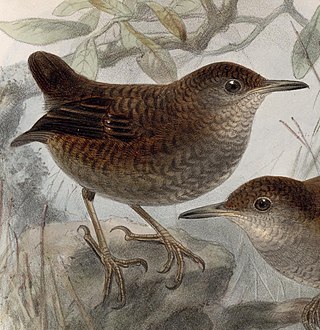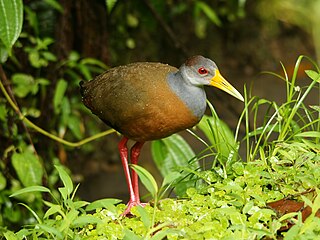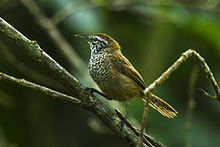
The northern rough-winged swallow is a small, migratory swallow. It is very similar to the southern rough-winged swallow, Stelgidopteryx ruficollis.

The rufous-breasted wren is a small songbird of the family Troglodytidae. It is found in Colombia, Costa Rica, Panama, Trinidad and Tobago, and Venezuela.

The streak-backed oriole is a medium-sized species of passerine bird from the icterid family. It is native to Central America and Mexico and is an occasional visitor to the United States.

The rufous-backed wren is a songbird of the family Troglodytidae. It is a resident breeding species from southwest Mexico to northwestern Costa Rica.

The azure-crowned hummingbird is a species of hummingbird in the "emeralds", tribe Trochilini of subfamily Trochilinae. It is found in Belize, El Salvador, Guatemala, Honduras, Mexico, and Nicaragua.

Canivet's emerald is a species of hummingbird in the "emeralds", tribe Trochilini of subfamily Trochilinae. It is found in Belize, Costa Rica, El Salvador, Guatemala, Honduras, Mexico, and Nicaragua.

The scaly-breasted hummingbird or scaly-breasted sabrewing is a species of hummingbird in the "emeralds", tribe Trochilini of subfamily Trochilinae. It is found in Belize, Colombia, Costa Rica, Guatemala, Honduras, Mexico, Nicaragua, and Panama.

The Central American pygmy owl is a species of owl in the family Strigidae. It is found in Belize, Colombia, Costa Rica, Ecuador, Guatemala, Honduras, Mexico, Nicaragua, and Panama.

The maroon-chested ground dove is a species of bird in the family Columbidae. It is found in Bolivia, Colombia, Costa Rica, Ecuador, El Salvador, Guatemala, Honduras, Mexico, Panama, Peru, and Venezuela.

The grey-chested dove is a species of bird in the family Columbidae. It is found in Belize, Colombia, Costa Rica, Guatemala, Honduras, Mexico, Nicaragua, and Panama.

The tody motmot is a species of passerine bird in the motmot family Momotidae. It is the only species placed in the genus Hylomanes. It is found in Belize, Colombia, Costa Rica, El Salvador, Guatemala, Honduras, Mexico, Nicaragua, and Panama.

The grey-breasted crake is a species of bird in subfamily Rallinae of family Rallidae, the rails, gallinules, and coots. It is found in Belize, Costa Rica, Guatemala, Honduras, Nicaragua, Panama, Trinidad and Tobago, and every mainland South American country except Chile and Uruguay.

The song wren is a species of bird in the family Troglodytidae. It is found in Colombia, Costa Rica, Ecuador, Honduras, Nicaragua, and Panama.

The northern nightingale-wren, or nightingale wren, is a species of passerine bird in the family Troglodytidae. It is found in Belize, Costa Rica, Guatemala, Honduras, Mexico, and Nicaragua.

Cabanis's wren is a species of bird in the family Troglodytidae. It is found in Belize, Costa Rica, El Salvador, Guatemala, Honduras, Mexico, and Nicaragua.

The speckle-breasted wren is a species of bird in the family Troglodytidae. It is found in Colombia, Ecuador, and Peru.

The black-headed trogon is a species of bird in the family Trogonidae. It is found in Belize, Costa Rica, El Salvador, Guatemala, Honduras, Mexico, and Nicaragua.

The gartered trogon, also known as the northern violaceous trogon, is a near passerine bird in the family Trogonidae, the quetzals and trogons. It is found in Mexico, all of Central America, and Colombia, Ecuador, Peru, and Venezuela.

The crowned woodnymph or violet-crowned woodnymph is a species of hummingbird in the "emeralds", tribe Trochilini of subfamily Trochilinae. It is found from Belize and Guatemala to northern Peru.

The russet-naped wood rail or rufous-naped wood rail is a species of bird in the subfamily Rallinae of the rail, crake, and coot family Rallidae. It is found from Mexico to Costa Rica.






















